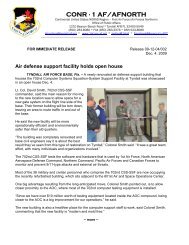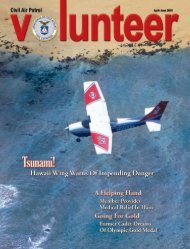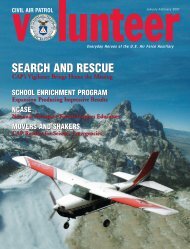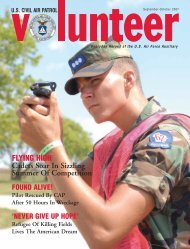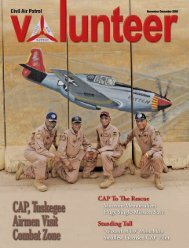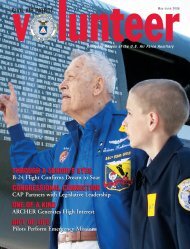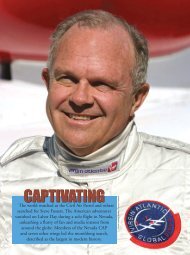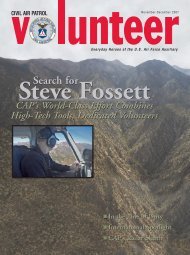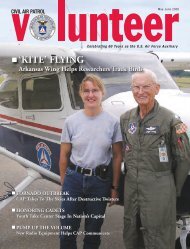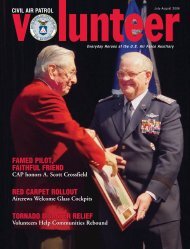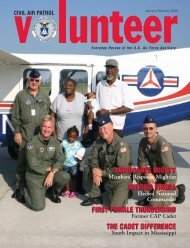GIVING BACK
Hi-res - CAP Volunteer Now
Hi-res - CAP Volunteer Now
- No tags were found...
Create successful ePaper yourself
Turn your PDF publications into a flip-book with our unique Google optimized e-Paper software.
Photo by Lt. Col. John Schmidt, Kansas Wing<br />
A Kansas Wing photograph taken above Greensburg, Kan.,<br />
shows some of the damage resulting from an F5 tornado packing<br />
205 mph winds that destroyed most of the town on May 4.<br />
CAP members in aircraft and on ground teams volunteered<br />
more than 300 hours to help their communities in the aftermath<br />
of the deadly storms.<br />
alone was struck a total of four times.<br />
Aircrews in four Cessna aircraft flew along tornado<br />
paths for 20 hours reporting severely damaged areas to<br />
CAP’s ground search and rescue teams. Digital photos of<br />
the damage were e-mailed to the state’s Emergency<br />
Operations Center.<br />
CAP ground teams also served an additional 40 hours<br />
assisting with regional communications and checking for<br />
devastation at various locations.<br />
1st Lt. Arthur Grover drove to Greensburg Airport and<br />
found it mostly unscathed, then went to check on several<br />
private landing strips.<br />
“There was one place, a hotel, where the roof was off<br />
and there was a car sitting on its nose in one of the<br />
rooms,” he said.<br />
At Kansas Wing Headquarters in Salina, members<br />
there put in more than 240 hours of the 300 total, manning<br />
radios to coordinate communications between air,<br />
ground and command staff as well as other agencies, such<br />
as the Kansas Air National Guard. Members there also<br />
worked on flight lines, directing and parking aircraft.<br />
“Our primary mission was to look for people in distress,<br />
or, where it appeared there was major damage or<br />
people trapped, we were supposed to call in or photograph<br />
that information so the Kansas National Guard or<br />
air/ground ambulances could respond,” said Pearson.<br />
Pearson said the wing’s work helped guide relief<br />
efforts.<br />
“The information we passed on caused the Kansas<br />
National Guard and Highway Patrol to redeploy their<br />
resources to areas that were hit harder, which relieved us<br />
to leave a little sooner and it helped them concentrate<br />
their resources where needed,” he said.<br />
CAP National Commander Maj. Gen. Antonio J.<br />
Pineda applauded the missions.<br />
“The work our volunteers performed in Kansas exemplifies<br />
the dedication and love of country of CAP members<br />
across America who help their communities in times<br />
of peace, but especially during crises,” he said. “It also<br />
highlights the capabilities of CAP to use advanced technology<br />
like satellite-transmitted digital imaging to take<br />
airborne photography of damaged areas and immediately<br />
send these via e-mail to emergency managers.” ▲<br />
I take pictures here?’<br />
vator.<br />
— Lt. Col. John Schmidt, Kansas Wing vice commander<br />
”<br />
U. S. Civil Air Patrol Volunteer 11 July-August 2007



